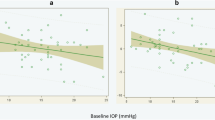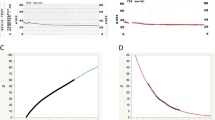Abstract
Background
Fluorophotometry and pneumotonography were performed to investigate the effect of Latanoprost 0.005% and Placebo on aqueous humor flow and total outflow facility in human glaucomatous eyes.
Methods
In a randomised double-blind clinical study patients with POAG and OHT received either latanoprost 0.005% or placebo once in the evening. Fluorophotometry (Fluorotron Master II, Ocumetrics) and Pneumatonography (Model 30 Classic Pneumatonometer, Mentor) was performed in 20 eyes of 10 patients (verum) and 22 eyes of 11 patients (placebo). During a 2 week wash-out period all patients received a systemic antiglaucomatous therapy (Acetazolamide) up to 3 days before baseline measurement. Patients with an IOP higher than 28 mmHg at baseline were excluded. Fluorophotometry, tonography and IOP were measured at baseline after 1 and 2 weeks of treatment. Data was analysed by the Student’s paired t test.
Results
All patients completed the protocol. The IOP significantly decreased (25%) after 1 and 2 weeks of treatment with Latanoprost (p<0.01). Fluorophotometry measurements showed no difference in flow over time in both groups. Although tonographic mean C values in both groups did not show any difference over time, the estimated total outflow facility C (Goldmann) increased significantly (p<0.05) in the verum-treated eyes after 2 weeks. A significant difference of outflow coefficient correlated to normal pressure (P0/C) was found after 2 weeks of treatment with Latanoprost (p<0.05).
Conclusions
In accordance with the literature we found a mean 25% decrease in IOP after 2 weeks of treatment with Latanoprost 0.005%. The analysis of flow values in both groups showed no increase or decrease in aqueous humor dynamics as proved in many previous studies. The known effect of Latanoprost to increase uveoscleral outflow by remodeling extracellular matrix and widening intermuscular spaces in the ciliary body may not be detected by pneumatonography after 2 weeks of treatment. The significant increase in estimated total outflow facility (Goldmann formula) in latanoprost-treated eyes and the decrease of IOP took place at constant flow rates. The increase in conventional outflow facility may indicate trabecular meshwork changes, but it cannot explain the significant decrease in IOP. Furthermore, an additional effect, e.g. uveoscleral outflow, may play the major role as considered in many previous studies.
Similar content being viewed by others
References
Anthony TL, Pierce KL, Stamer WD, Regan JW (1998) Prostaglandin F2α receptors in the human trabecular meshwork. Invest Ophthalmol Vis Sci 39:315–321
Ayvazian JH, Ayvazian LF (1961) A study of the hyperuricemia induced by hydrochlorothiazide and acetazolamide. J Clin Invest 40:196
Brubaker RF (1991) Flow of aqueous humor in humans. Invest Ophthalmol Vis Sci 32:3145
Camras CB, Siebold EC, Lustgarten JS et al. (1989) Maintained reduction of intraocular pressure by prostaglandin F2α -1-iospropyl ester applied in multiple doses in ocular hypertensive and glaucoma patients. Ophthalmology 96:1329–1337
Camras CB et al. (1987) Multiple dosing of prostaglandin F2a or epinephrine on cynomolgus monkey eyes: I. Aqueous humor dynamics. Invest Ophthalmol Vis Sci 28:463
Camras CB et al. (1988) Multiple dosing of prostaglandin F2a or epinephrine on cynomolgus monkey eyes. III. Histopathology. Invest Ophthalmol Vis Sci 29:1428
Crawford K, Kaufman PL, Gabelt BT (1987) Effects of topical PGF2a on aqueous humor dynamics in cynomolgus monkeys. Curr Eye Res 6:1035
Fristrom B, Nilsson SE (1993) Interaction of PHXA41, a new prostaglandin analogue, with pilocarpine: a study on patients with elevated intraocular pressure. Arch Ophthalmol 111:662–665
Gabelt B, Kaufman P (1998) Normal physiology. In: Alm A, Weinreb R (eds) Uveoscleral outflow. Mosby-Wolfe, London, pp 25–40
Gabelt B, Kaufman P (2000) Uveoscleral outflow decreased in old rhesus monkeys. Invest Ophthalmol Vis Sci 41:253
Gabelt BT, Kaufman PL (1989) Prostaglandin F2α increases uveoscleral outflow in the cynomolgus monkey. Exp Eye Res 49:389–402
Gabelt BT, Kaufman PL (1990) The effect of prostaglandin F2α on trabecular outflow facility in cynomolgus monkeys. Exp Eye Res 51:87–91
Goodfield M, Davis J, Jeffcoate W (1982) Acetazolamide and symptomatic metabolic acidosis in mild renal failure. Br Med J 284:422
Grant WM (1950) Tonographic method for measuring the facility and rate of aqueous flow in human eyes. Arch Ophthalmol 44:204
Grant WM (1951) Clinical measurements of aqueous outflow. Arch Ophthalmol 46:113
Hoskins D, Kass MA (1989) Tables for tonometry and tonography. In: Hoskins D, Kass MA (eds) Becker-Shaffer’s diagnosis and therapy of the glaucomas, 6th edn. Mosby, St. Louis
Kaufman PL (1986) Effects of intracamerally infused prostaglandins on outflow facility in cynomolgus monkey eyes with intact or retrodisplaced ciliary muscle. Exp Eye Res 43:819
Lee PY, Podos SM, Severin C (1984) Effect of prostaglandin F2a on aqueous humor dynamics of rabbit, cat, and monkey. Invest Ophthalmol Vis Sci 25:1087
Linner E (1955) Episcleral venous pressure during tonography. Acta XVII Congr Ophthalmol 3:1532
Lutjen-Drecoll E, Tamm E (1988) Morphological study of the anterior segment of cynomolgus monkey eyes following treatment with prostaglandin F2a. Exp Eye Res 47:761
Nilsson SF et al. (1989) Increased uveoscleral outflow as a possible mechanism of ocular hypotension caused by prostaglandin F2a-1-isopropylester in the cynomolgus monkey. Exp Eye Res 48:707
Pederson JE, Gaasterland DE, MacLellan HM (1977) Uveoscleral aqueous outflow in the rhesus monkey: importance of uveal reabsorption. Invest Ophthalmol Vis Sci 16:1008
Selen G et al. (1991) Effects of PhXA34 and PhDA100A, two phenyl substituted prostaglandin esters, on aqueous humor dynamics and microcirculation in the monkey eye. Invest Ophthalmol Vis Sci 32 (Suppl):869
Svedbergh B, Forsberg I (1993) A morphological study on the effects of chronic administration of latanoprost (LP) on the ciliary muscle and trabecular meshwork in monkeys. Invest Ophthalmol Vis Sci 34 (Suppl):932
Tamm E, Rittig M, Lutjen-Drecoll E (1990) Electromikroskopische and immunohistochemische Untersuchungen zur augendrucksenkender Wirkung von Prostaglandin F2a. Fortschr Ophthalmol 87:623
Toris C, Yablonski M, Wang Y, Camras C (1999) Aqueous humor dynamics in the aging human eye. Am J Ophthalmol 127:407–412
Toris CB, Camras CB, Yablonski ME (1993) Effects of PhXA41, a new prostaglandin F2a analog, on aqueous humor dynamics in human eyes. Ophthalmology 100:1297
Tripathi RC (1977) Uveoscleral drainage of aqueous humour. Exp Eye Res 25 (Suppl):305
Tripathi RC, Tripathi BJ (1982) Functional anatomy of the anterior chamber angle. In: Jacobiec FA (ed) Ocular anatomy, embryology, and teratology. Harber and Row, Philadelphia, p 276
Tripathi RC (1972) Aqueous outflow pathway in normal and glaucomatous eye. Br J Ophthalmol 56:157–174
Tripathi RC, Yang C, Tripathi BJ, Borisuth NS (1992) Role of receptors in the trabecular meshwork of the eye as targeted to the development of antiglaucoma therapy. Drug Development Res 27:191–228
Villumsen J, Alm A (1989) Prostaglandin F2α -isopropylester eye drops: effects in normal human eyes. Br J Ophthalmol 73:419–426
Villumsen J (1992) Effects in human eyes of topical prostaglandin F2α - isopropylester and 17-phenyl substituted analogues of prostaglandin F2α - isopropylester. Umea University Medical Dissertations. ISSN 0346–6612
Wiederholt M, Thieme H, Stumpff F (2000) The regulation of trabecular meshwork and ciliary muscle contractility. Prog Retinal Eye Res 19:271–295
Ziai N, Dolan JW, Kacere RD, Brubaker RF (1993) The effects on aqueous dynamics of PhXA41, a new prostaglandin F2 alpha analogue, after topical application in normal and ocular hypertensive human eyes. Arch Ophthalmol 111:1351–1358
Acknowledgement
The study was supported by a grant from Pharmacia GmbH, Erlangen, Germany
Author information
Authors and Affiliations
Corresponding author
Rights and permissions
About this article
Cite this article
Dinslage, S., Hueber, A., Diestelhorst, M. et al. The influence of Latanoprost 0.005% on aqueous humor flow and outflow facility in glaucoma patients: a double-masked placebo-controlled clinical study. Graefe's Arch Clin Exp Ophthalmol 242, 654–660 (2004). https://doi.org/10.1007/s00417-003-0835-1
Received:
Revised:
Accepted:
Published:
Issue Date:
DOI: https://doi.org/10.1007/s00417-003-0835-1




